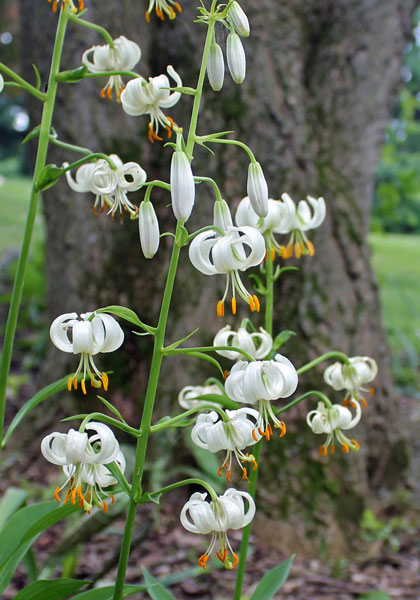|
|


|
|
The small, graceful blossoms of this luminous wildflower seem made by fairies. Like its lavender-pink cousin, it requires a cool site, filtered sun, humus-rich soil, and patience as it settles in — but it’s worth it. 3-5 feet, very early summer, zones 3a-7a(8bWC), from Holland. |
|
TYPE martagon SUB TYPE martagon, species, turk's-cap, wildflower ZONES 3a-7a(8bWC) HEIGHT 3-5’ BLOOM SEASONS early summer LIGHT half sun, light shade |
PLANTING & CARELilies are more perishable than most bulbs, so plant them as soon as possible. If necessary, store briefly in plastic in the refrigerator, away from fruit. Lily bulbs often feel a bit soft, and a little Penicillium mold is common, but neither is cause for alarm. Remove brown or mushy scales. Well-drained soil is essential for lilies! Avoid or improve clay soil, or plant in raised beds. If the soil is also fertile and humusy, that’s ideal, and most lilies prefer soil it slightly acidic. Tiger lily and Henry’s lilies are two lilies that thrive in neutral to alkaline soils. Good air circulation is also critical for lilies, so keep this in mind when siting them. Most lilies prefer a sunny (but not hot) or very lightly shaded site in the North, or afternoon shade in the South. Exceptions are martagons, martagon hybrids such as ‘Guinea Gold’, and Lilium superbum, all of which do best in light or dappled shade in the North and partial shade further south. In the North, choose a sunny (but not hot) or very lightly shaded site. In the South, give afternoon shade. Good air circulation is critical, too. Plant so bulbs are covered with three to four times their height in soil. Deeper is better than shallower, except in heavy (clay) soils. Space most lilies 9-18 inches apart, depending on their ultimate size. Smaller lilies such as L. pumilum and the martagons, for example, can be planted 6-12 inches apart. Lilies like their heads in the sun but their feet in shade, so add a good mulch to help keep the soil cool and moist or over-plant with low-growing annuals or companionable perennials. Water as you would other perennials; lilies like moisture (though not heavy, water-logged soil). Rich soil is good, but heavy fertilizing is NOT recommended. Add a winter mulch in the North to help keep sprouts from emerging too early (and being damaged by late frost). Be prepared to stake the heavy heads of some lilies in bloom, especially those grown in less than full sun. Like many perennials, lilies rarely reach their full height, bloom, or beauty the first year, but your patience and good care will be rewarded. The red lily leaf beetle is a new pest that’s spreading through New England and beyond. Hand-picking and neem-based insecticides are two widely recommended controls. Learn more here. For more about growing and enjoying lilies, see our Lilies Newsletter Archives and Bulbs as Cut-Flowers page. |

|
SPRING
|
· |
SUMMER
|
· |
FALL
|
· |
LEARN MORE
|
· |
ORDERING
|

|










